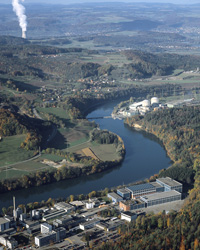Function of facility

Zwilag as linking pin between the generation of waste and its long-term storage in deep geological repositories
In Switzerland, the producers of radioactive waste are responsible for its safe disposal. The Swiss disposal concept sees the final solution as the long-term storage of radioactive waste in repositories located in suitable rock formations. Until it can be finally stored underground, radioactive waste must be kept in interim storage for 30 to 40 years until it no longer emits any heat. For low- and medium-level waste, an interim storage facility can bridge the time gap until the commissioning of a deep geological repository. Treatment plants are available for preparing the waste for final disposal in deep geological repositories.
All categories of radioactive waste generated in Switzerland are processed and temporarily stored in the Zwilag facility and the neighbouring Federal interim storage facility. These are primarily:
- Operational waste and spent fuel rods from the nuclear power plants.
- Waste of all categories from the reprocessing of spent fuel rods from Swiss sources in foreign reprocessing plants.
- Processing of waste for which the Confederation is responsible, i.e. radioactive waste from research, health care and industrial applications.
The location neighbouring on the Paul Scherrer Institute (which the Confederation uses for many years as an interim storage facility for radioactive waste) has several advantages: by combining the waste processing plants and central interim storage facility, the waste can be optimally combined and transports can be reduced. In addition, the waste can be optimally monitored and controlled.
